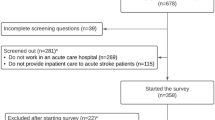Abstract
A needs assessment for a hospital-based dysphagia program was conducted to determine incidence, management procedures, and outcome for stroke patients with swallowing disorders. Using a chart review of 225 patients, it was found that 28% had documented evidence of dysphagia. When dysphagia co-occurred with stroke, significantly more functional problems and medical complications were reported, as well as increased need for dietary modifications and alternative feeding methods. The dysphagic patients were more often aphasic and dysarthric and less able to communicate. Mental status was more likely to be reduced and the need for staff supervision during mealtime was increased. Dysphagic patients had significantly longer hospital stays, thus increasing the cost of their care. At discharge, almost half of them continued to need feeding modifications, which may have delayed rehabilitation or transfer to facilities with other levels of care. The dysphagia group clearly displayed a wide range of clinical symptoms that would alert staff to their risk for medical complications because of swallowing problems. We believe that this needs assessment clearly showed that a multidisciplinary dysphagia management program has the potential to enhance patient care while decreasing the cost of health care delivery for the hospital.
Similar content being viewed by others
References
Gordon C, Hewer RL, Wade DT: Dysphagia in acute stroke.Br Med J 295:411–414, 1987
Veis SL, Logemann JL: Incidence and nature of swallowing disorders in CVA patients. Paper presented at ASHA meeting, San Francisco, 1984
Veis SL, Logemann JL: Swallowing disorders in persons with cerebrovascular accident.Arch Phys Med Rehab 66:372–375, 1985
White-Martin BJ:Researching, Developing and Marketing a Comprehensive Swallowing Program in a Health Care Setting: A Guide for Speech-Language Pathologists. Gaylord, MI: Northern Speech Services, 1987
Groher M: The prevalence of swallowing disorders in two teaching hospitals.Dysphagia 1:3–6, 1986
Winstein CJ: Neurogenic dysphagia: frequency, progression and outcome in adults following head injury.Phys Ther 63:1992–1997, 1983
Erlihman M: Public Health Service assessment: The role of speech pathologists in the management of dysphagia. Rockville, MD: National Center for Health Services, 1989
Groher ME:Dysphagia: Diagnosis and Management. Stoneham, MA: Butterworth, 1984
Jones PL, Altschuler SL: Dysphagia teams: a specific approach to a non-specific problem.Dysphagia 1:200–205, 1987
Author information
Authors and Affiliations
Rights and permissions
About this article
Cite this article
Young, E.C., Durant-Jones, L. Developing a dysphagia program in an acute care hospital: A needs assessment. Dysphagia 5, 159–165 (1990). https://doi.org/10.1007/BF02412640
Issue Date:
DOI: https://doi.org/10.1007/BF02412640




